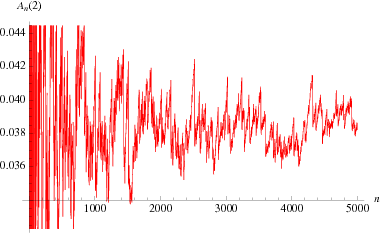

تاريخ الرياضيات

الاعداد و نظريتها

تاريخ التحليل

تار يخ الجبر

الهندسة و التبلوجي


الرياضيات في الحضارات المختلفة

العربية

اليونانية

البابلية

الصينية

المايا

المصرية

الهندية


الرياضيات المتقطعة

المنطق

اسس الرياضيات

فلسفة الرياضيات

مواضيع عامة في المنطق


الجبر

الجبر الخطي

الجبر المجرد

الجبر البولياني

مواضيع عامة في الجبر

الضبابية

نظرية المجموعات

نظرية الزمر

نظرية الحلقات والحقول

نظرية الاعداد

نظرية الفئات

حساب المتجهات

المتتاليات-المتسلسلات

المصفوفات و نظريتها

المثلثات


الهندسة

الهندسة المستوية

الهندسة غير المستوية

مواضيع عامة في الهندسة

التفاضل و التكامل


المعادلات التفاضلية و التكاملية

معادلات تفاضلية

معادلات تكاملية

مواضيع عامة في المعادلات


التحليل

التحليل العددي

التحليل العقدي

التحليل الدالي

مواضيع عامة في التحليل

التحليل الحقيقي

التبلوجيا

نظرية الالعاب

الاحتمالات و الاحصاء

نظرية التحكم

بحوث العمليات

نظرية الكم

الشفرات

الرياضيات التطبيقية

نظريات ومبرهنات


علماء الرياضيات

500AD

500-1499

1000to1499

1500to1599

1600to1649

1650to1699

1700to1749

1750to1779

1780to1799

1800to1819

1820to1829

1830to1839

1840to1849

1850to1859

1860to1864

1865to1869

1870to1874

1875to1879

1880to1884

1885to1889

1890to1894

1895to1899

1900to1904

1905to1909

1910to1914

1915to1919

1920to1924

1925to1929

1930to1939

1940to the present

علماء الرياضيات

الرياضيات في العلوم الاخرى

بحوث و اطاريح جامعية

هل تعلم

طرائق التدريس

الرياضيات العامة

نظرية البيان
Abundant Number
المؤلف:
Behrend, F.
المصدر:
"Über numeri abundantes." Sitzungsber. Preuss. Akad. Wiss., Phys.-Math. Kl.
الجزء والصفحة:
...
8-11-2020
1088
Abundant Number
An abundant number, sometimes also called an excessive number, is a positive integer  for which
for which
 |
(1) |
where  is the divisor function and
is the divisor function and  is the restricted divisor function. The quantity
is the restricted divisor function. The quantity  is sometimes called the abundance.
is sometimes called the abundance.
A number which is abundant but for which all its proper divisors are deficient is called a primitive abundant number (Guy 1994, p. 46).
The first few abundant numbers are 12, 18, 20, 24, 30, 36, ... (OEIS A005101).
Every positive integer  with
with  is abundant. Any multiple of a perfect number or an abundant number is also abundant. Prime numbers are not abundant. Every number greater than 20161 can be expressed as a sum of two abundant numbers.
is abundant. Any multiple of a perfect number or an abundant number is also abundant. Prime numbers are not abundant. Every number greater than 20161 can be expressed as a sum of two abundant numbers.
There are only 21 abundant numbers less than 100, and they are all even. The first odd abundant number is
 |
(2) |
That 945 is abundant can be seen by computing
 |
(3) |

Define the density function
|
(4) |
(correcting the expression in Finch 2003, p. 126) for a positive real number  where
where  gives the cardinal number of the set
gives the cardinal number of the set  , then Davenport (1933) proved that
, then Davenport (1933) proved that  exists and is continuous for all
exists and is continuous for all  , and Erdős (1934) gave a simplified proof (Finch 2003). The special case
, and Erdős (1934) gave a simplified proof (Finch 2003). The special case  then gives the asymptotic density of abundant numbers,
then gives the asymptotic density of abundant numbers,
 |
(5) |
The following table summarizes improvements in bounds on the constant over time.
| value | reference |
 |
Behrend (1933) |
 |
Wall (1971) and Wall et al. (1977) |
 |
Deléglise (1998) |
 |
Kobayashi (2010, p. 12) |
REFERENCES:
Behrend, F. "Über numeri abundantes." Sitzungsber. Preuss. Akad. Wiss., Phys.-Math. Kl., No. 21/23, 322-328, 1932.
Behrend, F. "Über numeri abundantes. II." Sitzungsber. Preuss. Akad. Wiss., Phys.-Math. Kl., No. 6, 280-293, 1933.
Davenport, H. "Über numeri abundantes." Sitzungsber. Preuss. Akad. Wiss., Phys.-Math. Kl., No. 6, 830-837, 1933.
Deléglise, M. "Bounds for the Density of Abundant Integers." Exp. Math. 7, 137-143, 1998.
Dickson, L. E. History of the Theory of Numbers, Vol. 1: Divisibility and Primality. New York: Dover, pp. 3-33, 2005.
Erdős, P. "On the Density of the Abundant Numbers." J. London Math. Soc. 9, 278-282, 1934.
Finch, S. R. "Abundant Numbers Density Constant." §2.11 in Mathematical Constants. Cambridge, England: Cambridge University Press, pp. 126-127, 2003.
Guy, R. K. Unsolved Problems in Number Theory, 2nd ed. New York: Springer-Verlag, pp. 45-46, 1994.
Kobayashi, M. "On the Density of Abundant Numbers." Ph.D. thesis. Hanover, NH: Dartmouth College, 2010.
Singh, S. Fermat's Enigma: The Epic Quest to Solve the World's Greatest Mathematical Problem. New York: Walker, pp. 11 and 13, 1997.
Sloane, N. J. A. Sequence A005101/M4825 in "The On-Line Encyclopedia of Integer Sequences."
Souissi, M. Un Texte Manuscrit d'Ibn Al-Bannā' Al-Marrakusi sur les Nombres Parfaits, Abondants, Deficients, et Amiables. Karachi, Pakistan: Hamdard Nat. Found., 1975.
Wall, C. R. "Density Bounds for the Sum of Divisors Function." In The Theory of Arithmetic Functions: Proceedings of the Conference at Western Michigan University, April 29-May 1, 1971. (Ed. A. A. Gioia and D. L. Goldsmith). New York: Springer-Verlag, pp. 283-287, 1971.
Wall, C. R.; Crews, P. L.; and Johnson, D. B. "Density Bounds for the Sum of Divisors Function." Math. Comput. 26, 773-777, 1972.
Wall, C. R.; Crews, P. L.; and Johnson, D. B. "Density Bounds for the Sum of Divisors Function." Math. Comput. 31, 616, 1977.
 الاكثر قراءة في نظرية الاعداد
الاكثر قراءة في نظرية الاعداد
 اخر الاخبار
اخر الاخبار
اخبار العتبة العباسية المقدسة

الآخبار الصحية















 قسم الشؤون الفكرية يصدر كتاباً يوثق تاريخ السدانة في العتبة العباسية المقدسة
قسم الشؤون الفكرية يصدر كتاباً يوثق تاريخ السدانة في العتبة العباسية المقدسة "المهمة".. إصدار قصصي يوثّق القصص الفائزة في مسابقة فتوى الدفاع المقدسة للقصة القصيرة
"المهمة".. إصدار قصصي يوثّق القصص الفائزة في مسابقة فتوى الدفاع المقدسة للقصة القصيرة (نوافذ).. إصدار أدبي يوثق القصص الفائزة في مسابقة الإمام العسكري (عليه السلام)
(نوافذ).. إصدار أدبي يوثق القصص الفائزة في مسابقة الإمام العسكري (عليه السلام)


















